By Juror13 and guest-blogger, Cottonstar
The battered justice system had creaked and shuddered, but it had worked! We had not been indicted! People would have to finally see the jury’s decision as our vindication.”
– John Ramsey, Death of Innocence, 2000
That wasn’t the jury’s decision. More importantly, John Ramsey knew that wasn’t their decision when he and Patsy co-wrote their book the following year. That’s fraud. Rather than saying we weren’t formally indicted by the DA, which is factually true, he chose to manipulate the narrative and instead say the jury – a group of their peers – vindicated them. They did not.
One would think, now that the grand jury indictments are public knowledge after Judge Robert Lowenbach unsealed them in 2013, that John would be a little humbler with his responses regarding the jury’s vote.
When asked by CNN in September 2016 how he felt about being labeled an accessory to Murder via the indictments, his response:
“Really? I didn’t know that. I don’t even know what that means, frankly.” – John Ramsey
Frankly, nobody’s buying it anymore. In fact, Aphrodite Jones, who previously believed an intruder was likely responsible for the crime, spoke to Tricia Griffith on Websleuths Radio this week and said she’s since changed her mind.

In 2011, Aphrodite wanted to sincerely explore the intruder theory. In support of her show, she interviewed John San Agustin, one of the Ramseys’ (multiple) private investigators, as well as John Ramsey in private [for three hours]. She describes San Agustin’s lengthy PowerPoint presentation, including crime scene photos, fancy slides about Touch DNA, and stun guns, as a “nicely wrapped present”. Add to that Mary Lacy’s public exoneration letter to the Ramseys, and indeed it was a gift – for the Ramseys. It worked. It wasn’t until this past year that Aphrodite started to look at the case in more detail, partly due to some of the insights shared by the investigators involved in the CBS show. What she discovered was that there was clearly a diligent effort on behalf of Team Ramsey to distort the investigation.
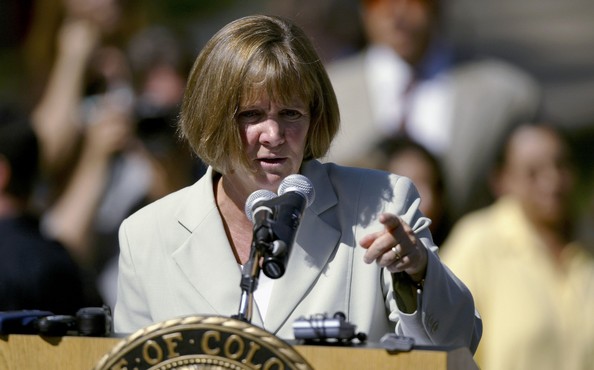
As Tricia pointed out, why wouldn’t you believe a DA; never before have we ever seen anything as outrageous as a DA “exonerating” individuals while a case is still open. So at face value, one may be inclined to believe the DA had good reason to clear the family.
“I feel that I had been taken for a ride.” – Aphrodite Jones, October 15, 2017
Believe me, Aphrodite, you’re not alone.
In a People magazine article from December 2016, current DA Stan Garnett says then Boulder DA, Mary Lacy, jumped the gun on July 9, 2008, when, on the basis of DNA analysis from the crime scene, she issued a letter to John Ramsey stating “we do not consider your immediate family including you, your wife, Patsy, and your son Burke to be under any suspicion. “When any district attorney goes around and starts issuing exonerations based on a particular piece of evidence, that can be very misleading to the public about the nature of the case.”
For 20+ years, the Ramseys have misled and bullied the public. They’ve hypocritically sat down for interviews and documentaries, touting “the truth [will be] uncovered” while chastising so many others for trying to do the same. Lin Wood, goes so far as to describe seasoned investigators who participated in the CBS show as playing “an acting role”. Meanwhile, John is seen “acting” out his new life for the camera, walking on the beach, hand-in-hand with Jan, walking thru picturesque mountains, hob-nobbing with legal analysts. The narrative, I suppose, is that we should think John is a really swell guy.
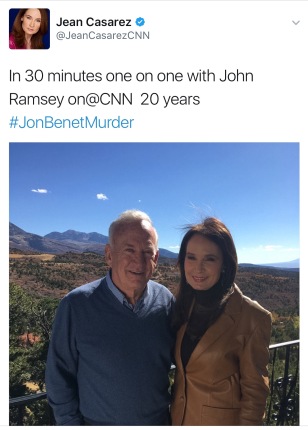

Nevertheless, the public continues to dissent, and team Ramsey responds by suing somebody else. The latest civil suit filed by John last month, brings us to at least twelve suits (on behalf of Burke and themselves) to-date, related to the case.
If you read through the Complaint, you’ll find, many of the central arguments are rehashed from suit to suit. Their arguments are old and for the most part, consistent. What’s far less consistent is what the Ramseys have uttered to the police, to TV and newspaper reporters, and written in their books, over the years.
Cottonstar, who’s vigorously investigated this case, and I, teamed up to analyze the Factual Allegations set out in John’s Complaint.
What is a Factual Allegation? An allegation, of course, is a claim or assertion that somebody has done something wrong, typically absent of proof. Factual allegations in a legal complaint have one purpose – to narrate a story. If the Factual Allegations don’t satisfy each element of the complaint, the case faces dismissal. John Ramsey’s claims, we feel, are flagrantly unsatisfactory.
Lin Wood recently told Westword during a Q&A that one of the central claims in John’s lawsuit is the accusation that John perpetrated a criminal cover-up of the crime [CBS asserts] committed by Burke.
Wood sells this as if it’s the most absurd thing he’s ever heard. I guess, just like John, Wood kinda sorta forgot that a Grand Jury, after examining the evidence, also believed John may have committed a criminal cover-up [was an accessory to Murder] and wanted him to answer to those allegations at trial. It would be nice if rather than completely and repeatedly evading the details of the indictment by moaning about unsophisticated jurors and ham sandwiches, somebody on Team Ramsey could actually, intelligently, address the following:
On or about December 25, and December 26, 1996 in Boulder County, Colorado, John Bennett Ramsey did unlawfully, knowingly and feloniously render assistance to a person, with intent to hinder, delay and prevent the discovery, detention, apprehension, prosecution, conviction and punishment of such person for the commission of a crime, knowing the person being assisted has committed and was suspected of the crime of Murder in the First Degree and Child Abuse Resulting in Death. – Count VII [A True Bill]
Since the statute of limitations for these charges has long since passed, it’ll never adequately be addressed in court. All we can do now, for the time being, is address the fraud perpetrated by the Ramseys, with the help of their council, by pointing out their changing stories.
Note: The complaint contains 141 Factual Allegations. For purposes of brevity, we’ve addressed some of the most glaring contradictions and mendacious statements.
FACTUAL ALLEGATIONS & OUR REBUTTAL
- Twenty years later, with the crime remaining unsolved, Defendants stole the headlines and viewership by maliciously and falsely accusing John of covering-up Burke’s crime in their four-hour Documentary, which they promised would reveal JonBenet’s killer.
REBUTTAL: Burke Ramsey’s interview with Dr. Phil was the first JonBenet special to air in September 2016, ahead of the other special programming, including CBS’s The Case of: JonBenet Ramsey. Weren’t John and Burke Ramsey the ones to “steal the headlines” by jockeying to have their interview broadcast first? Also, let’s not ignore that Dr. Phil and John Ramsey share Lin Wood as their lawyer and both men conveniently appeared on the show in defense of Burke, along with Dr. Phil – not exactly an impartial host – who defended Burke himself in Episode 3. Making sure you’re first in line to share your story is indeed controlling the narrative, is it not?
- Both the judicial system and the Boulder County District Attorney’s Office have previously declared John’s innocence in the death of his daughter.
REBUTTAL: While John may enjoy a presumption of innocence, considering the case never went to trial, a judicial system has not declared John innocent.
- Despite being fully aware of Judge Carnes’ order, Defendants ignored and did not disclose the Wolf Decision during the Documentary, including many of key facts and information cited therein in support of Judge Carne’s decision.
REBUTTAL: First, the purpose of the CBS show was to investigate the homicide of JonBenet Ramsey, not to revisit a civil case filed by a journalist, presided over by Judge Carnes. Second, see the first paragraph of this blog post. The Ramseys repeatedly made public statements about the Grand Jury clearing them of all charges, when they knew that was a total fabrication. When John and Patsy appeared on Connecting Point with Reverend Wayne Cordiero, on a show where John praised God and spoke of living a good and spiritual life, he not only lied, but threw in a joke for good measure when he said [at 7:25 in the video]: “Thankfully the system did work. Obviously a grand jury looked at our case and said, No. And [chuckling] I will always be available for jury duty now that I see how important it is.”
- On July 9, 2008, former Boulder DA Lacy relied on newly discovered [Touch] DNA evidence to officially exonerate the Ramsey family (including John) in an open letter released to the public. DA Lacy found: New scientific evidence convinces us that it is appropriate, given the circumstances of this case, to state that we do not consider your immediate family including you, your wife, Patsy, and your son, Burke, to be under any suspicion in the commission of this crime. [snipped]
REBUTTAL: First, start with this article which talks about the efficacy of Touch DNA. Then consider this…. From thedailycamera.com: …experts said the evidence showed that the DNA samples recovered from the long johns came from at least two people in addition to JonBenet – something Lacy’s office was told, according to documents obtained by the Camera and 9NEWs, but that she made no mention of in clearing the Ramseys. The presence of a third person’s genetic markers has never before been publicly revealed. The presence of that DNA on JonBenet’s underwear and long johns, be it from one or multiple people, may very well be innocent; the profiles were developed from minute samples that could have been the result of inconsequential contact with other people, or transferred from another piece of clothing.” And this is the rock-solid evidence Lacy used to declare this murder a “DNA case” and in turn, completely cleared the Ramsey family of any wrong-doing.
- In early 1998, former Boulder PD Chief Mark Beckner stated during a news conference that Burke was not involved in the killing of JonBenet, was not a suspect in JonBenet’s murder, and was not being looked at as a suspect.
REBUTTAL: If they’re referring to the well-known, televised press conference by Becker, the date was actually Dec 1997, not early 1998. Beckner says in December 1997, “one of the most important tasks yet to do is the re-interviewing of some family members, specifically Mr. and Mrs. Ramsey, and their son, Burke Ramsey. We have made a formal request for these interviews and do expect this to completed in the near future.”
“We have an umbrella of suspicion and people have come and gone under that umbrella. They [the Ramseys] do remain under an umbrella of suspicions, but, uh, we’re not ready to name any suspects.” When asked if Burke was a suspect, Beckner answered “At this time, we’re treating him as a witness.” The implication of that statement is not the same as “Burke was not involved in the killing of JonBenet.”

When asked why they were calling the Ramseys back, Beckner also says “it’s been 6 months since they last spoke with them and “it’s not unusual to call people back and re-interview, especially in a case that’s this complex. Also understand, it’s been approximately 6 months since we last interviewed the Ramseys During that time, there’s been a lot of investigation, we’ve uncovered a lot of new information, we have a lot of new questions, and, uh, they can help us answer those questions. They are significant in this case and they have information that’s important to us.”
- In a sworn affidavit dated October 12, 2000, former Boulder DA Alex Hunter reaffirmed under oath that Burke had never been a suspect in the investigation into his sister’s murder. [snipped]
REBUTTAL: From sequin star 2000-2006: Alex Hunter didn’t devise this affidavit on his own. He was propositioned by Lin Wood on October 11, 2000, to sign an already written [by Wood] affidavit that would help minimize any future appearances by the DA’s office, including Hunter, in further Burke Ramsey litigation. It’s important to note that Hunter didn’t automatically agree to sign what Wood sent him. In fact, the portions of the affidavit that Hunter either revised or deleted are telling. The following is the suggested Paragraph 6 that Hunter revised before signing:
“All questions related to Burke Ramsey’s possible involvement in the murder of JonBenet Ramsey were resolved to the satisfaction of the investigators and Burke Ramsey has never been viewed by investigators as a suspect in connection with the murder of his sister.” And here’s what Hunter agreed to sign:
“From December 26, 1996, to the date of this affidavit, no evidence has ever been developed in the investigation to justify elevating Burke Ramsey’s status from that of witness to suspect.” In other words, just because Burke wasn’t formally named a “suspect” doesn’t mean he wasn’t or hasn’t [or won’t be] investigated. Hunter address this by deleting paragraph 9 and not replacing it. Here’s the deleted text that he felt was necessary to remove before signing:
“from December 26, 1996 to the date of this Affidavit, Burke Ramsey has not been and is not at present, a suspect in the investigation into the murder of his sister, JonBenet Ramsey.”
- After the family returned home, John and Patsy put their children to bed and went to bed themselves soon after.
REBUTTAL: In Linda Arndt’s police report, she stated: “JonBenet and her brother, Burke, went to bed shortly after the family returned home. John Ramsey had read to JonBenet after she’d gone to bed, and before she went to sleep. This, reportedly, is what John told Arndt that morning. Of course, he denies it, but Arndt doesn’t. It was the last time John would mention reading in his narrative. In all subsequent questioning, John never mentions reading again.
- Burke did not leave his bedroom during the night.
REBUTTAL to 112 & 117: Burke said on Dr. Phil, in response Dr. Phil’s question about him sneaking out [that night] and going downstairs to play: “Yea. I remember being downstairs after everyone was kinda in bed.”
- John and Patsy checked on Burke, who appeared to them to be sleeping in his room.
REBUTTAL: In Death of Innocence from 2000, and John’s book, the Other Side of Suffering from 2012, both John and Patsy claim to have gone to check on Burke, yet this is in contradiction to what Patsy stated in both her April 1997 and June 1998 interviews with police. She says she didn’t check on Burke.
TRUJILLO: Right around the corner. Okay. When did you check on Burke during all this? You talked about John going to check on Burke.
PATSY: Yeah. I think he ran and check on him when I was up, up there uh, you know, it just all happened so fast. I said, ‘Oh, my God. What about Burke?’ And I think he ran in and checked him while I was running back downstairs or something.
TRUJILLO: Okay.
PATSY: But I remember he, you know, I think he ran and checked on him and, and he told me he was okay or whatever.
TRUJILLO: Okay. Was Burke still in the same bed? He hadn’t moved beds or anything like that?
PATSY: I don’t know. I didn’t go in there and look.
HANEY: Okay. Do you ever go up and check on Burke, you yourself?
PATSY: Oh, yeah. I mean, you mean like that or —
HANEY: This morning, the 26th. Let’s get you back there. We are still pacing around?
PATSY: Right. I don’t think I did. I think John said he was fine
- John opened the door to the Wine Cellar, turned on the light, and discovered JonBenet’s body.
This is also addressed later in John’s complaint with the following point:
- Defendants [CBS] knew and failed to disclose that John turned the light on before finding JonBenét as confirmed by John and the sole witness, Fleet White.
REBUTTAL: John has no recollection of turning on the light, so he can’t factually state that he did. From John’s deposition in Wolf v Ramsey, 2001:
HOFFMAN: When you opened the cellar door, can you describe with the best of your recollection today, what it was that you saw?
JOHN: I saw a white blanket and I knew immediately, I’d found JonBenét.
HOFFMAN: Had you turned the light on? Or.
JOHN: I don’t remember turning the light on (shaking head from side to side)
- The Ramsey home was not secure on the night of December 25, 1996. They had not turned their security alarm on, and at least seven windows and one door were found unlocked on the morning of December 26, 1996. A door from the kitchen to the outside was found open.
REBUTTAL: In Perfect Murder, Perfect Town, Linda Hoffman-Pugh, the Ramsey’s housekeeper, recalls a conversation with Patsy at the memorial service in Boulder:
“Who could have done this to JonBenét?” Patsy asked.
“I wish I knew,” I said. “Are you sure you had all the doors locked?”
“Yes, we are sure.”
“Are you sure you pushed the button on the patio door?”
“We had all the windows and doors locked,” Patsy said.
- A rope was found inside of a brown paper sack in the guest bedroom on the second floor.
REBUTTAL: The rope was not found in a brown paper sack as proven by the questioning of John by Smit in June 1998. The brown paper sack seen in the picture was a Boulder PD evidence bag, yet, Wood seems to be implying in his Factual Allegation that somebody carried this rope into the house in a bag. The rope was found in John Andrew’s back pack (used for climbing/scouting activities – John Andrew, just like Burke, was a scout)
SMIT: But he could have had things there in his [John Andrew’s] backpack?
RAMSEY: It wouldn’t have been out of the question.
SMIT: Just for the camera, the photographs we are looking at is photo 113, 114, 115 and 116. – (0535-24)
MORGAN: May I ask just one question. Can you tell us if this is the form in which it was originally found?
SMIT: No, that’s the bag it was put in for evidence.
MORGAN: So the paper bag is just in evidence.
SMIT: Evidence bag. And again that was just found in the room, and it was found in a bag in her room, that’s all I can tell you at this time.
- Small pieces of the material of this brown sack were found in JonBenét’s bed and in the body bag that was used to transport her body.
REBUTTAL: Revisit point #170 above, and you’ll understand just how mischievous this is. Yes, there were pieces of brown sack found in the body bag and in JonBenet’s bed because it’s from the evidence bags used to collect evidence at the crime scene – as is typical in all investigations.

- John and Patsy disclaimed ownership and knowledge of that rope.
REBUTTAL: In Patsy’s June 1998 interview, she couldn’t seem to recall the rope, yet, the rope, or one identical, can be seen in numerous pictures taken around the home from various timeframes.
PATSY: “I don’t recognize it, specifically.”
DEMUTH: “Okay. And that, that particular piece of rope, do you ever remember seeing anything like it around? And if you look at photo 115, you notice the… ends are unusually secured… can you think of any reason to have that kind of rope around?”
PATSY: “I’ve just never seen ends like that, done like that. John had some, you know, boat ropes and things up at the lake, but it seems like when they cut those they kind of melt the ends of them or something to keep them from fraying or something. I’ve never seen one done like that.”
DEMUTH: “The kind of ropes you’re talking about that John used up there”
PATSY: “For the sailboat or”
DEMUTH: “Are they colored the same or similar?”
PATSY: “Well, some of them have like little blue flecks in them or red, or there’s some white ones, you know.”
DEMUTH: “Okay. Do you know what, what those are composed of? Is it a nylon-like that melts?”
PATSY: “Yeah, it must, something that melts, yeah. But it seems to me like they somehow torch the ends and kind of keep them from fraying. I can’t remember seeing any one looking like that.”
DEMUTH: “You don’t remember that being used anywhere in the house or yard or”
PATSY: “No”
DEMUTH: “Would you think that unusual to be found in the house?”
PATSY: “Yeah, I mean, Burke had some ropes that he would play with through something out on the playground, you know, in that, in that picture yesterday the rope around the, the fort, you know, or something.”
DEMUTH: “Right”
PATSY: “Always trying to make a boat or something like that.”
DEMUTH: “This was found inside the house”
PATSY: “Inside the house?”
DEMUTH: “In John Andrew’s room?”
PATSY: “Oh. Maybe it was a, some rope he used for camping or something, I don’t know.”
DEMUTH: “Did he have rope in his room that he would use for camping?”
PATSY: “…I don’t know. I just don’t remember seeing this specifically, and I don’t remember ever seeing a rope like that.”
DEMUTH: “Do you know John Andrew had a rope in that room?”
PATSY: “No”

- An unidentified baseball bat was found on the north side of the house containing fibers consistent with fibers found in the carpet in the basement where JonBenét Ramsey’s body was found.
REBUTTAL: Burke on Dr. Phil: “They showed me a picture of the baseball bat like on the side of the house or something [referring to the black bat on the ledge]. That was my baseball bat.” And by claiming ownership of that bat – he then claims ownership of the basement carpet fibers on the bat as well.
- In 2013, it was leaked to the media that the grand jury had voted to recommend that John and Patsy be indicted by the Boulder DA for “commit[ting] a child to be unreasonably placed in a situation which posed a threat of injury to the child’s life or health” and for “render[ing] assistance to a person with the intent to hinder, delay and prevent the discovery, detention, apprehension, prosecution, conviction and punishment of such a person knowing the person being assisted has committed and was suspected of the crime of Murder in the First Degree and Child Abuse Resulting in Death.”
REBUTTAL: The [unsigned] True Bill Grand Jury indictments weren’t leaked. Charlie Brennan successfully filed suit in court requesting the documents be made public, citing the Freedom of Information Act, and the judge unsealed the documents. Unsealed documents are public record. To my point from the beginning of this post, it resonates that all Lin Wood can say about these extremely damning indictments is that they’re leaked, and even that’s not true.
We’ll leave it at that… for now… and will leave you with this thought from one of the [anonymous] grand jurors who voted to indict John and Patsy on four counts, collectively, in 1999.
“It’s still unresolved,” one juror said. “Somebody did something pretty horrible that wasn’t punished. I’m not saying that I am at peace. But I had sympathy with his (Hunter’s) decision. I could see the problem that he was in. I could understand what he was doing.” – Daily Camera, 1/27/13
Why would a juror who spent over a year of their time considering the evidence be understanding of Hunter’s decision to ignore their vote? What do the jurors know?
shakedowntitle.com





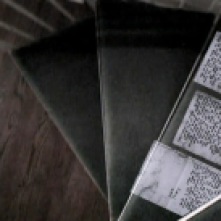







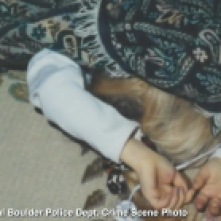




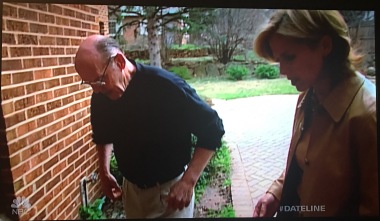
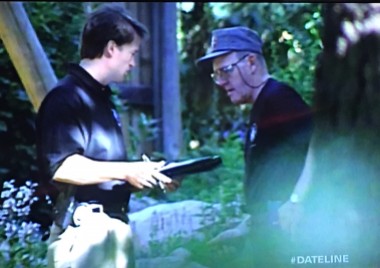















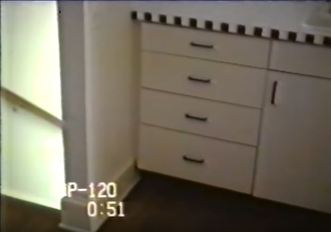




 unknown location, until they were given to the police upon request some time after 09:30.
unknown location, until they were given to the police upon request some time after 09:30. 













 cleaning [the wood shavings] up… [Burke had] been asked to do it over paper or a bag or something. So, I just put the knife up one day, in a cupboard over the sink in that area outside of JonBenét’s room” on the home’s second level, an area that also had a microwave and laundry facilities. Hoffman-Pugh said she didn’t tell JonBenét’s parents where she stowed Burke’s knife.
cleaning [the wood shavings] up… [Burke had] been asked to do it over paper or a bag or something. So, I just put the knife up one day, in a cupboard over the sink in that area outside of JonBenét’s room” on the home’s second level, an area that also had a microwave and laundry facilities. Hoffman-Pugh said she didn’t tell JonBenét’s parents where she stowed Burke’s knife.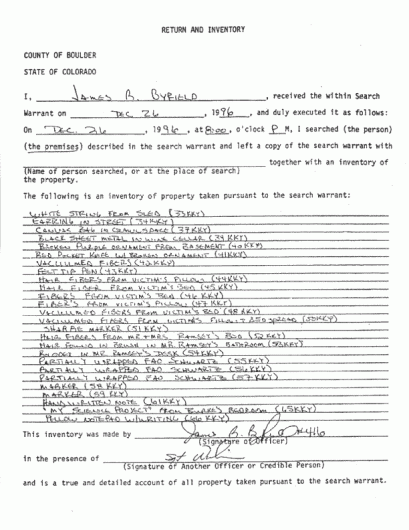



 include whittling/kindling wood and the mastery of cords, rope and knots.
include whittling/kindling wood and the mastery of cords, rope and knots.





 At first, the window was no big deal to John. He didn’t seem to want to draw attention to it. If you want to make the case that someone came in from the outside of the house and broke in, wouldn’t you be cheerleading a broken window as prima facie, bona fide whoopdedoo evidence? So why does John not even mention it to the cops that morning? As a concerned parent he should be waving a great big flag at it. So why doesn’t he?
At first, the window was no big deal to John. He didn’t seem to want to draw attention to it. If you want to make the case that someone came in from the outside of the house and broke in, wouldn’t you be cheerleading a broken window as prima facie, bona fide whoopdedoo evidence? So why does John not even mention it to the cops that morning? As a concerned parent he should be waving a great big flag at it. So why doesn’t he? window well to this window was not secured. John had been locked out of the house. John told us he removed the grate, kicked in the basement window, and gained entrance to the house from this window. John told us he had not re-secured the window nor had he fixed the window which he had broken.
window well to this window was not secured. John had been locked out of the house. John told us he removed the grate, kicked in the basement window, and gained entrance to the house from this window. John told us he had not re-secured the window nor had he fixed the window which he had broken.




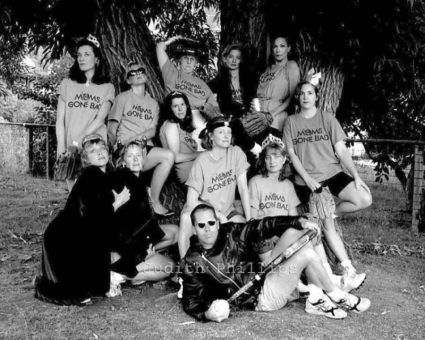


 the interrogation via the psychology of the children. It’s underestimated how much damage the sibling rivalry and parental short-sightedness does to the child’s personality (and the adults who go with the flow!) It’s so clear, in this telling of yours, that there were always two “only child” offspring in the house: first a son who is the only child until a sister comes along. He becomes the “other” child while she is given the turn at being the “only.” If only the father had adopted his own boy as fiercely as she sank her teeth into her girl. There’d still have been damaged young people growing up – but they’d at least have grown up physically together and possibly lived equally long lives.
the interrogation via the psychology of the children. It’s underestimated how much damage the sibling rivalry and parental short-sightedness does to the child’s personality (and the adults who go with the flow!) It’s so clear, in this telling of yours, that there were always two “only child” offspring in the house: first a son who is the only child until a sister comes along. He becomes the “other” child while she is given the turn at being the “only.” If only the father had adopted his own boy as fiercely as she sank her teeth into her girl. There’d still have been damaged young people growing up – but they’d at least have grown up physically together and possibly lived equally long lives.

